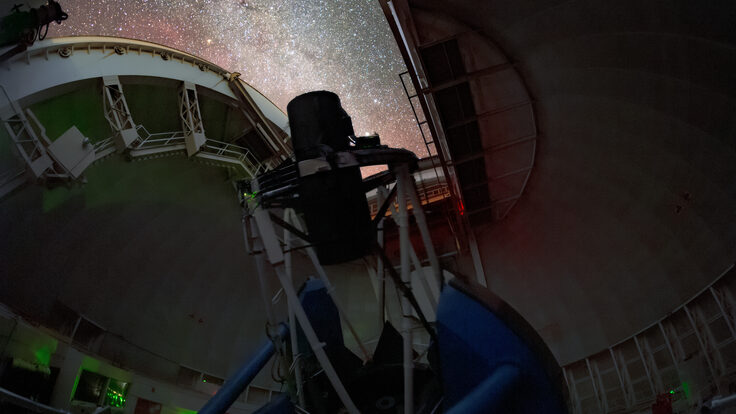A lab away from home
by Elizabeth Clements
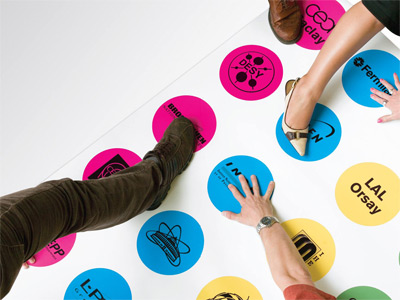 |
| Photo: Reidar Hahn, Fermilab |
It's a stretch: In search of new skills, particle physicists spend months or years at labs far from home, absorbing culture along with science.
Dogs get jet lag. That's what Tor Raubenheimer, a physicist at the Stanford Linear Accelerator Center in California, learned when he moved in 1996 for a one-year fellowship at CERN, the European particle physics lab. It took months for his Samoyed and Malamute to get over the change in time zones, he says: "It was a real problem because they would get up in the middle of the night and want to play."
Nick Walker faced an even more unlikely problem when he relocated from CERN to SLAC in the 1980s: people didn't want his money, at least not in cash. "Coming from Europe, I didn't have a US bank account or any credit cards," says Walker, who is now a physicist at Hamburg's DESY lab. When he tried to buy furniture for his apartment, he quickly learned that stores were suspicious of purchases involving hundreds of dollars in cash: "I actually had trouble spending money because the stores wouldn't sell me anything."
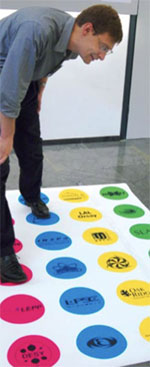 |
| At recent meetings in Germany and the United States, ILC scientists acted out their travels on an improvised Twister game board. Photo: Barbara Warmbein, ILC |
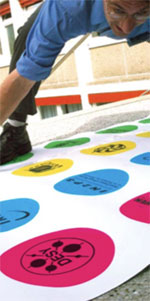 |
| Photo: Barbara Warmbein, ILC |
Today both Raubenheimer and Walker play leading roles in building the next big proposed accelerator, the International Linear Collider (ILC). As members of the Global Design Effort, they help set strategy and priorities for the project. That means spending more than half their time on the road, traveling to meetings and workshops.
Despite all the travel-related hassles they have encountered, both physicists will tell you their extended stays at other laboratories, often in other countries, made it easier for them to do their jobs today. And they'd like more members of the ILC community to do the same.
To them, it's a way to make the Global Design Efforta virtual organization without any physical headquartersslightly less virtual. In addition, beyond their value as cultural exchanges, these trips are a way of spreading the critical technologies and expertise that the ILC demands. In a tradition as old as physics, one scientist learns from another, working side by side in the lab, absorbing technical lore and passing it on to colleagues back home.
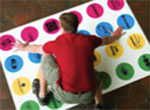 |
| Photo: Reidar Hahn, Fermilab |
"I would like us to be more nomadic," says Raubenheimer. "It would be much better for the project if we all traveled together and spent more time at other labs."
Living in a new placebe it a strange city or a different continent takes you out of your element, away from the comforts of home. It can make you more vulnerable. Perhaps it is that vulnerability, not wanting to be alone in a foreign environment, that casts off your shell. When people sit in a meeting room together, share a meal together, or drink a beer together, cultural barriers can melt away and trust, even friendship, seep in.
"If we are going to build the ILC together, we have to learn to trust and interact with each other," Raubenheimer says. "All of us do better by spending time in other places."
Studying abroad
Fermilab's Damon Bice is "studying abroad" at Jefferson Laboratory (JLab) in Newport News, Virginia, learning how to process and test superconducting cavities. Made of superconducting niobium, these meter-long, hollow structures are the heart of the ILC, accelerating beams of particles to energies of 500 billion electronvolts. But the tiniest speck of dust can cause them to lose their superconductivity; so following a detailed series of chemical treatments and other preparatory steps is extremely important.
More than half-way through his year-long training, Bice is quickly becoming an expert. "I really like the challenge it poses, and it is nice to start from scratch on a new project," he says.
Bice turned his attention to the ILC after spending 10 years at Fermilab, working on magnets to be installed in the Large Hadron Collider (LHC) at CERN. The decision to move from Chicago to Virginia wasn't easy. Bice has a 12-year-old son and a 5-year-old daughter, and his wife was in the middle of getting a degree in psychology at National Louis University. "We had a house and had to decide what to do with our belongings," he says. "It's been a lot of changes." Bice's son temporarily transferred junior high schools, his daughter will start kindergarten in Virginia, and his wife is continuing her studies through an online program.
Despite all the difficulties of moving and adjusting to a new lab, Bice and his family decided the career opportunity was worth it. Just as he was part of the LHC magnet project at Fermilab from the very beginning, he's joining the ILC effort at an early stage.
Under the tutelage of JLab's John Mammosser, Bice spent a few weeks observing the experts before beginning to clean and assemble cavities on his own. This meant many hours inside a clean room, dressed head to toe in protective gear. "I had never been in a clean room before, and it was hard to get used to working in there," he says. But he quickly learned tricks for working in the confines of the new environment: "I started changing my glove size for different tasks, for example, which helps a lot when you are working with really small parts."
Bice is one of nearly 100 visiting scientists Mammosser has trained in his 18 years at JLab. For his part, Mammosser learned by working with experts at KEK lab in Japan.
"I always recommend that scientists go to other places to learn because they get to watch and see how other people do things. It makes you more well-rounded," says Mammosser, who left JLab in May to train technicians at Oak Ridge National Laboratory in Tennessee. "It's our obligation to train people, and we should share our knowledge. That's the whole point of what we do."
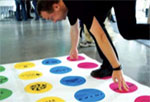 |
| Photo: Elizabeth Clements, ILC |
Passing it on
Many of JLab's experts in superconducting technology started out at Cornell University in Ithaca, New York, where the mentoring tradition continues today. Cornell's Hasan Padamsee and Curtis Crawford, for instance, are imparting their expertise to Fermilab's Bill Ashmanskas, who hopes to train other technicians when he gets back.
"My career has been defined by mentors," says Ashmanskas. "Each stage has had a different mentor, and this stage fits right in. Every couple of years, I seek out a new set of gurus to work with, and it gives me the opportunity to learn a whole new set of skills."
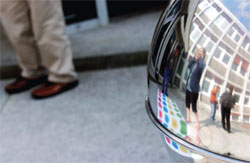 |
| Photo: Barbara Warmbein, ILC |
Ashmanskas relocated to upstate New York in December 2006 for one year, enduring a long, snowy winter that made the Chicagoan feel right at home. He had no previous experience with superconducting cavities and says he found the small-university environment at Cornell beneficial. "It's the ideal place for me to come to learn," he says, "because everything exists here on a small enough scale that I can touch it."
From etching and rinsing the cavities to testing and tuning them, Ashmanskas participates in every meticulous step of their preparation. Although he has been reading the only available textbook on superconducting cavitiesit was written by his mentor, PadamseeAshmanskas finds it easier to learn by first working with his hands. "When we eventually start to make thousands of these cavities, we will have a much different setup," he says. "Learning in a close-knit R&D environment like the one at Cornell will make me a much more useful participant in Fermilab's program and will pay off in the long run."
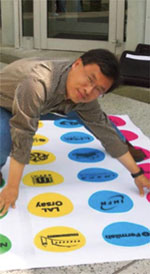 |
| Photo: Barbara Warmbein, ILC |
Every bit helps
Not everyone can spend months away from home. When KEK's Norihito Ohuchi wanted to spend time at DESY to observe the assembly of cryomodulesvessels that chill the superconducting cavitiesobligations at his home institution tugged him back. "I wanted to watch the whole assembly for two months," he says. "But I have a responsibility to operate the superconducting magnet system for KEKB, and three weeks was all I could manage."
Despite the short visit, Ohuchi still learned enough about cryomodules to help technicians who are now commissioning the Superconducting Test Facility at KEK. "I could imagine the assembly process for the STF cryomodules at KEK only after coming back to Japan from DESY," he says.
Setting an example for other senior scientists working on the ILC, SLAC's Tom Himel is about to start a year's sabbatical at DESY. His wife will join him, and his daughter, a student at New York University, will spend a semester studying in Prague. This will make the year abroad easier, but there are still the simple tasks, like going to the bank in Hamburg, that become not so simple when you don't speak the language. For Himel, who focuses on the ILC's protection systema set of mechanisms that prevent the machine from breaking downthe opportunity to get involved in DESY's Tesla Technology Facility, essentially a working prototype of the ILC, is worth the effort. "I want to see the daily realities," he says. "It's the questions that you didn't know to ask that you get the answers to, and you can't do that remotely."
 |
| Photo: Barbara Warmbein, ILC |
Click here to download the pdf version of this article.




